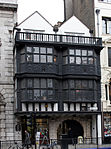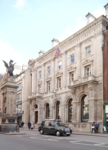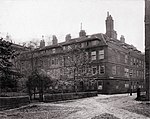Nando's Coffee House

Nando's was a coffee house in Fleet Street in London. It was known to exist in 1696, being the subject of a conveyance, and was popular in the 18th century, especially with the legal profession in the nearby courts and chambers. The name is thought to be a contraction of "Ferdinand's" or "Ferdinando's", and its exact address is given variously as somewhere between 15 and 17 Fleet Street. David Hughson wrote in 1807 that Nando's occupied the building at 15 Fleet Street which was previously the Rainbow Coffee House.The venue was a favourite haunt of Edward Thurlow, who became Lord Chancellor, and he was satirised as being enamoured of the landlady's attractive daughter.Charles Lamb refers to Nando's in his essay "Detached Thoughts on Books and Reading," writing, "Newspapers always excite curiosity. No one ever lays one down without a feeling of disappointment. What an eternal time that gentleman in black, at Nando's, keeps the paper! I am sick of hearing the waiter bawling out incessantly, 'The Chronicle is in hand, Sir.'"
Excerpt from the Wikipedia article Nando's Coffee House (License: CC BY-SA 3.0, Authors, Images).Nando's Coffee House
Fleet Street, City of London
Geographical coordinates (GPS) Address Nearby Places Show on map
Geographical coordinates (GPS)
| Latitude | Longitude |
|---|---|
| N 51.5137 ° | E -0.1111 ° |
Address
Kall Kwik
Fleet Street
EC4A 2LT City of London
England, United Kingdom
Open on Google Maps










